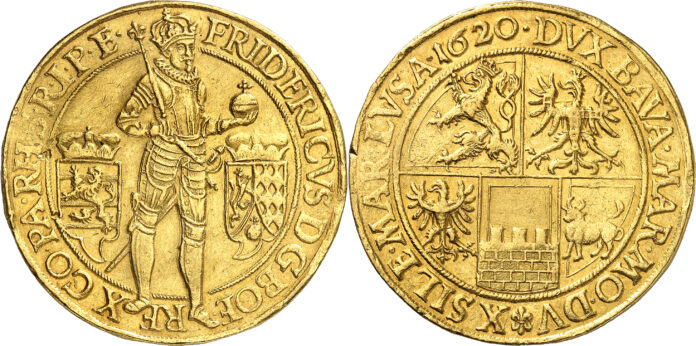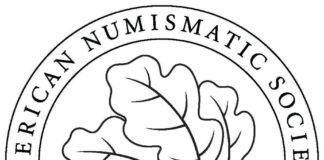The Top Ten of Künker’s Berlin Auction Sale
Every year, Künker’s Berlin Auction Sale is an absolute highlight. This year again, there was an abundance of interesting, extremely rare and historically significant pieces. This was reflected in the hammer prices. The total result of the 1,077 lots amounted to €10 million. Here you will find the most outstanding lots of this sale. The “top ten” article is limited to a detailed description of the top nine because the 10th place, with a hammer price of €80,000, goes to no less than three lots:
No. 1 – Brandenburg-Prussia, George William. 5 ducats 1627, Königsberg.
No. 375 – Mecklenburg, John Albert II. Double reichstaler 1616, Gnoien.
No. 784 – France, Louis XII. Ecu d’or au porc-épic n.d. (1507), Paris.
9th Place:
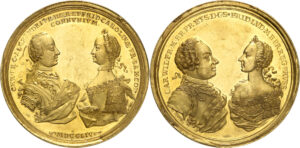
The 40fold ducat from Brandenburg-Ansbach minted on behalf of Charles William Frederick in 1754 on the occasion of the wedding of his son and Frederica Caroline of Saxe-Coburg-Saalfeld achieved a price of €85,000. Crucial reasons for the piece’s success were probably the unusual denomination as well as the fact that the coin is unique and was graded MS62 by NGC. However, the historical background of this commemorative coin shouldn’t be overlooked as well: it commemorates a marriage that heralded the beginning of the end of the margraviates of Brandenburg-Ansbach and Brandenburg-Bayreuth. The marriage of Carl Alexander and Frederica was so unfortunate that the heir the margrave had hoped for was never born. After Frederica’s death, the widower refused to enter into a dynastic marriage again. He sold his rule to Prussia in exchange for a life annuity, married his long-standing (and below his station) lover and moved to Great Britain, where he devoted the rest of his life to horse breeding.
7th Place (Twice):
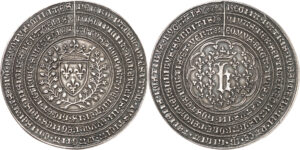
With a jump from 50,000 to 95,000 euros, two pieces achieved the same level, and thus both of them made 7th place.
The first is one of the earliest medals that commemorate a contemporary event. In 1455, King Charles VII of France had a silver medal weighing about 30g struck commemorating the expulsion of the English from his kingdom: the Hundred Years’ War, which almost united France and England under a single king, ended in 1453 with the expulsion of the English from Bordeaux. Only Calais remained under English control until 1558.

And that’s a perfect transition to the second piece that made 7th place with a hammer price of €95,000, too, because this coin was minted by the main opponent of the Hundred Years’ War: the English.
The piece is one of the extremely sought-after English 5 guinea pieces. It dates to 1686. Collectors and investors from all over the world are currently in love with these heavy gold coins and ensure a consistently high level of prices. Künker was able to offer a gem graded almost FDC that had been minted on behalf of James II two years before his replacement in the course of the Glorious Revolution. The result shows that many collectors would have loved to have this piece in their collection.
6th Place:
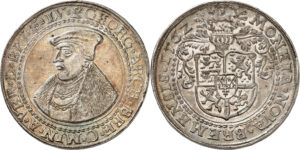
Once again, two pieces achieved the same result: €110,000. We assign the 6th and 5th place separately, according to the difference between estimate and hammer price. And therefore, the 6th place goes to the double taler of George of Brunswick estimated at €60,000 and featuring him as Archbishop of Bremen.
Despite his office as Archbishop of Bremen, George appears on this coin dressed in secular clothing. He belonged to the first generation of clergymen that had to deal with the ideas of the Reformation.
As the fourth eldest son of his family, he had made a career in the church, by the way – as it was still possible at that time – without ever having been ordained a priest. He was one of the leading pragmatists of the Reformation: he allowed his dioceses of Bremen and Verden to introduce the Reformation while keeping the Catholic creed in Minden, which he administered since 1554. What his own creed was? He may have been inclined to the Protestant faith. We do not know that because he publicly converted to Protestantism, but because he received the holy communion under both forms on his deathbed.
5th Place:
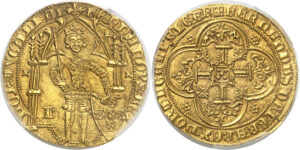
The Portuguese dobra pé terra of Fernando I climbed from an estimate of €50,000 to a hammer price of €110,000 and made thus the 5th place. And that should be no surprise as the coin is extremely rare and of major numismatic interest. It was minted in the context of a comprehensive monetary reform initiated by Fernando I in order to fund his costly wars with the neighbouring Kingdom of Castile.
He claimed to be closer related to the royal dynasty of Castile because of his mother’s family line. Therefore, he fought against Henry of Trastámara, an illegitimate son of the deceased Castile ruler who had catapulted himself to the top of Castile by murdering his brother. Although Fernando had no success in the battle for Castile, his monetary reform shaped Portuguese coinage for almost a century.
The most valuable coin of the entire system was the dobra pé terra of 120 soldi, which is extremely rare today and whose design was inspired by French coinage. Künker was able to offer a specimen of this piece of outstanding quality. PCGS graded the piece MS63. Moreover, the coin is of excellent provenance: it comes from the Huntington Collection auctioned off at Sotheby’s in 2012. It was thus part of the probably most spectacular series of coins from the Iberian Peninsula that has ever been offered on the market. The Hispanic Society of America sold the collection, which had been kept for decades by the ANS, in order to fund other projects.
4th Place:
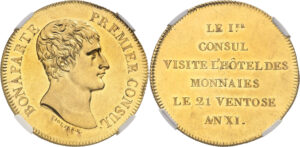
It was quite a surprise that the price of a rarity from the beginning of Napoleon’s reign increased from an estimate of €25,000 to a hammer price of €120,000! Well, it shouldn’t have been because we know almost for sure that the short Corsican held this very coin in his own hands.
On 20 Ventôse 11 – 12 March 1803 according to our calendar – Napoleon visited the mint in Paris. It was a surprise visit: the administration was informed at 6 a.m. that Napoleon was planning to come there at 8.30 a.m. of the same day. Nevertheless, we can assume that the mint expected him to visit the location because it is quite likely that it had been leaked to the Monnaie de Paris that an amendment of the monetary law was in preparation including a change in the coins’ motif: the usual depiction of Hercules between two female personifications was to be replaced with the portrait of the First Consul.
In fact, one of the medallists, Pierre-Joseph Tiolier, had already prepared the obverse die with the portrait, while his competitor, the chief engraver of the Monnaie de Paris Jean-Pierre Droz, preferred to stay at home that day. Was that the reason why Napoleon made Tiolier become chief engraver instead of Droz? Anyway, his obverse die was used to produce a medal under the eyes of Napoleon. Napoleon received the only golden piece whereas all those present were given a silver specimen as a souvenir of this important visit.
After the new monetary law had been adopted on 28 March 1803, the die with the portrait was used for regular coin production. The purchaser of the object offered by Künker has thus acquired a piece that is linked to the history of French coinage in a unique way.
3rd Place:
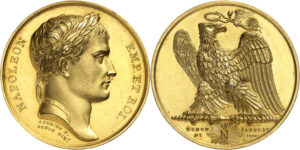
The immediately following piece of the auction is also associated with Napoleon. Its price jumped from an estimate of €75,000 to a hammer price of €130,000. Crucial factors were not only the perfect condition and the huge historical importance of the piece but also the fact that this medal was part of Napoleon’s private collection.
In 1975, coins and medals of the estate of Victor Bonaparte were offered under the title “Monnaie et Medailles Napoleoniennes”. And Victor Bonaparte had indeed inherited Napoleon’s collection, which consisted of patterns in gold that Napoleon had received for personal use. Among them was the medal offered at Künker as lot No. 249. Therefore, we can assume that, in 1807, Napoleon Bonaparte held this very medal in his hands in order to admire it.
2nd Place:
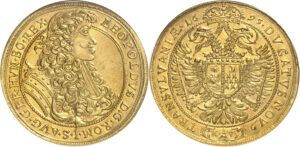
And now we arrived in the former Habsburg Empire. Coins from the Habsburg hereditary lands are currently experiencing a boom, especially if produced in rare mints. Coins from Transylvania are particularly sought-after, therefore, the 10fold ducat featuring the portrait of Leopold I minted in 1695 in Cluj-Napoca (today it’s the second largest city of Romania) had already an estimate of €80,000. Even such a high sum wasn’t enough. The piece was sold for €140,000!
1st Place:
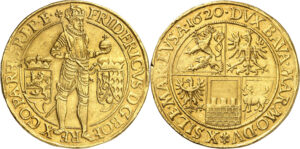
There was only a single coin that achieved a higher result while also experiencing the highest increase in price of all coins offered in this auction: the estimate was €25,000 but the piece was sold for €220,000! And that even though this rarity was only very fine +.
However, the historical importance of this coin for the history of the Holy Roman Empire cannot be exceeded: the piece is a 10fold ducat commissioned by the Winter King Frederick of the Palatinate in 1620 in Prague.
And therefore, historically speaking, the coin was struck at the beginning of the Thirty Years’ War, which changed Europe forever. The fight for Bohemia with its capital Prague was to begin. After the defenestration of Prague, Protestant forces in Bohemian saw the opportunity of replacing the Catholic Habsburg king with a Protestant – after all, Bohemia was, theoretically, an elective monarchy. A Protestant on the Bohemian throne would have resulted in a profound change in the majority-minority relationship within the electoral college, which elected the ruler of the empire. For the first time in history it would have been possible for a Protestant emperor to be elected.
But when Frederick V of the Palatinate was elected Bohemian king on 26 August 1619, it was already certain that the Protestant princes would not support him. Nevertheless, he had himself crowned on 4 November 1619 at St. Vitus Cathedral in Prague. The 10 ducat piece, which changed hands for €220,000 at this auction, must have been minted in the months following this event.
The king wasn’t able to spend another winter in Prague: his troops suffered a crushing defeat in the Battle of White Mountain on 8 November 1620. The king had to flee. His descendants were treated like outcasts during the Thirty Years’ War and probably would not have played a role on the European stage ever again if one of his daughters had not married the posthumous but energetic Duke of Brunswick…
But that is a different story: this extremely rare coin reminds us of the great hopes that Frederick of the Palatinate had when he arrived in Prague and the outcome of the Thirty Years’ War was still undecided.
If you buy a coin, you get its story for free. And that’s why coins still are the most popular collector’s item.
All results can be found at the Künker website: either in the online catalogue or as PDF.
Künker’s Spring Auction Sale will take place from 16 to 20 March 2020. The corresponding catalogue can be ordered at Künker, Nobbenburgerstr. 4a, 49 076 Osnabrück; phone: +49 541 / 96 20 20; fax: +49 541 / 96 20 222; or via e-mail. By calling this number you can also arrange a meeting if you are interested in a consignment.
Here you can read a comprehensive overview on the Spring Auction Sale.



